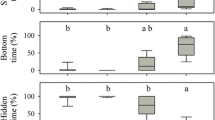Abstract
Glass eels of the temperate anguillid species, Anguilla japonica, clearly showed a nocturnal activity rhythm under laboratory conditions. Light–dark cycle was a determinant factor affecting their photonegative behavior, nocturnal locomotor activity, and feeding behavior. Under natural light conditions, glass eels remained in shelters with little daytime feeding, but came out to forage during darkness. They moved and foraged actively in the following dark, and then their activity gradually declined possibly because of food satiation. They finally buried in the sand or stayed in tubes immediately after the lights came on. Under constant light, glass eels often came out of the shelters to forage in the lights but spent little time moving outside the shelters (e.g. swimming or crawling on the sand). Glass eels took shelter to avoid light and preferred tubes to sand for shelter possibly because tubes were much easier for them to take refuge in than sand. Feeding and locomotor activities of the glass eels were nocturnal and well synchronized. They appeared to depend on olfaction rather than vision to detect and capture prey in darkness. Feeding was the driving force for glass eels to come out of sand under constant light. However, in the dark, some glass eels swam or crept actively on sand even when they were fully fed. The lunar cycles of activity rhythms of glass eels that have been observed in some estuarine areas were not detected under these laboratory conditions.
Similar content being viewed by others
References
Chen, Y.L. & H.Y. Chen. 1991. Temperature selections of Anguilla japonica (L.) elvers, and their implications for migration. Aust. J. Mar. Freshwater Res. 42: 743-750.
Deelder, C.L. 1958. On the behaviour of elvers (Anguilla vulgaris Turt.) migrating from the sea into fresh water. J. Cons. Int. Explor. Mer 24: 135-146.
Deelder, C.L. 1970. Synopsis of biological data on the eel Anguilla anguilla (Linnaeus) 1758. FAO Fish. Synopsis 80: 1-68.
Dou, S., J.M. Miller & K. Tsukamoto. 2003. Growth, pigmentation and activity of juvenile Japanese eel in relation to temperature and fish size. J. Fish. Biol. 63 (Suppl.): In press.
Edel, R.K. 1976. Activity rhythms of maturing American eels (Anguilla rostrata). Mar. Biol. 36: 283-289.
Edel, R.K. 1979. Locomotor activity of female silver eels (Anguilla rostrata) in response to shelter and unnatural photoperiods. Rapp. P.-v. Réun. Cons. Int. Explor. Mer 174: 98-103.
Gandolfi, G., M. Pesaro & P. Tongiorgi. 1984. Environmental factors affecting the ascent of elvers, Anguilla anguilla (L.), into the Arno River. Oebalia X, N.S.: 17-35.
Glova, G.J. & D.J. Jellyman. 2000. Size-related differences in diel activity of two species of juvenile eel (Anguilla) in a laboratory stream. Ecol. Freshwater Fish 9: 210-218.
Jellyman, D.J. 1979. Upstream migration of glass-eels (Anguilla spp.) in the Waikato River. N.Z. J. Mar. Freshwater Res. 13: 13-22.
Jellyman, D.J. 1991. Factors affecting the activity of two species of eel (Anguilla spp.) in a small New Zealand lake. J. Fish Biol. 39: 7-14.
Jellyman, D.J. & B.L. Chisnall. 1999. Habitat preferences of shortfinned eels (Anguilla australis), in twoNewZealand lakes. N.Z. J. Mar. Freshwater Res. 33: 233-248.
Kawakami, Y., N. Mochioka, R. Kimura & A. Nakazono. 1999. Seasonal changes of the RNA/DNA ratio, size and lipid contents and immigration adaptability of Japanese glass-eels, Anguilla japonica, collected in northern Kyushu, Japan. J. Exp. Mar. Biol. Ecol. 238: 1-19.
Kim, W.S., S.J. Yoon, H.T. Moon & T.W. Lee. 2002. Effects of temperature changes on the endogenous and exogenous rhythms of oxygen consumption in glass eels Anguilla japonica. Mar. Ecol. Prog. Ser. 243: 209-216.
McCleave, J.D. & R.C. Kleckner. 1982. Selective tidal stream transport in the estuarine migration of glass eels of the American eel (Anguilla rostrata). J. Cons. Int. Explor. Mer 40: 262-271.
McCleave, J.D. & G.S. Wippelhauser. 1987. Behavioral aspects of selective tidal stream transport in juvenile American eels (Anguilla rostrata). Am. Fish. Soc. Symp. 1: 138-150.
Sorensen, P.W., M.L. Bianchini & H.E. Winn. 1986. Diel foraging activity of American eels, Anguilla rostrata (Lesueur), in a Rhode Island estuary. Fish. Bull. 84: 746-747.
Sugeha, H.Y., T. Arai, M.J. Miller, D. Limbong & K. Tsukamoto. 2001. Inshore migration of the tropical eels Anguilla spp. recruiting to the Poigar River estuary on north Sulawesi Island. Mar. Ecol. Prog. Ser. 221: 233-243.
Tesch, F.-W. 1977. The Eel: Biology and Management of Anguillid Eels, Chapman and Hall, London. 434 pp.
Tsukamoto, K. 1992. Discovery of the spawning area for Japanese eel. Nature 356: 789-791.
Tsukamoto, K. & T. Arai. 2001. Facultative catadromy of the eel Anguilla japonica between freshwater and seawater habitats. Mar. Ecol. Prog. Ser. 220: 265-276.
Tzeng, W.N. 1985. Immigration timing and activity rhythms of the eel, Anguilla japonica, elvers in the estuary of northern Taiwan, with emphasis on environmental influences. Bull. Jap. Soc. Fish. Oceanogr. 47/48: 11-28.
van Veen, T., H.G. Hartwig & K. Müller. 1976. Light-dependent motor activity and photonegative behavior in the eel (Anguilla anguilla L.). J. Comp. Physiol. 111: 209-219.
Wippelhauser, G.S. & J.D. McCleave. 1988. Rhythmic activity of migrating juvenile American eels Anguilla rostrata. J. Mar. Biol. Ass. U.K. 68: 81-91.
Author information
Authors and Affiliations
Rights and permissions
About this article
Cite this article
Dou, SZ., Tsukamoto, K. Observations on the Nocturnal Activity and Feeding Behavior of Anguilla japonica Glass Eels Under Laboratory Conditions. Environmental Biology of Fishes 67, 389–395 (2003). https://doi.org/10.1023/A:1025894010739
Issue Date:
DOI: https://doi.org/10.1023/A:1025894010739




